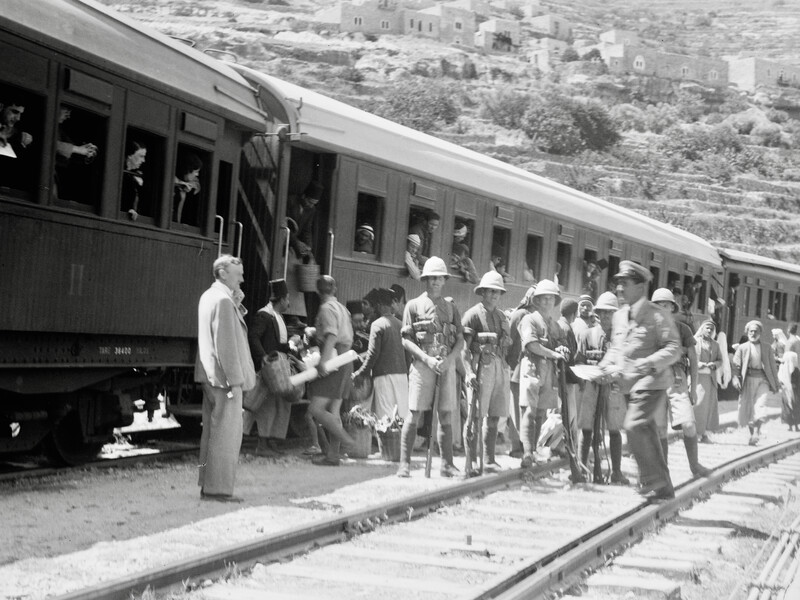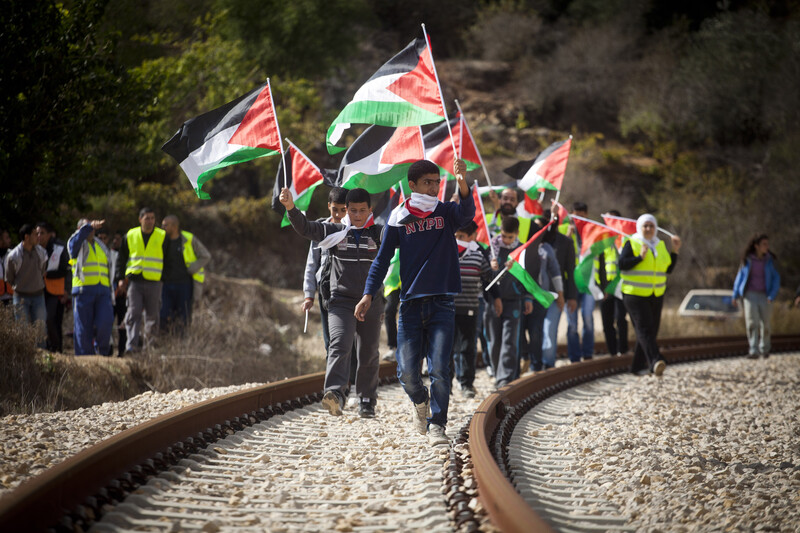The Electronic Intifada 15 May 2022

A passenger train with a British military escort at Battir station in 1936, during the Palestinian uprising. Village houses can be seen on the hill above. (American Colony Photo Department)
Seventy-four years ago, I witnessed the Nakba, the ethnic cleansing of Palestine. I experienced it from the perspective of a 12-year-old boy in my rural village of Battir.
Battir was linked by train to Jerusalem, about 12 kilometers away. The steam locomotive shuttled twice a day to the city, allowing villagers to bring their produce to market. Jerusalem was also where many people went to work, visited doctors and met other basic needs.
Though many in Battir were illiterate, each day newspapers would come from Jerusalem. People would gather and listen as someone read aloud the news of the events swirling around us and on which our future hinged.
For a long time, it was well understood that the British promise of a “Jewish national home” in Palestine was an existential threat. Adults talked about it all the time, and we as children overheard and shared their fears and anxieties.
Throughout the British Mandate, people supported resistance to the Zionist colonization of Palestine, especially during the 1936-39 Palestinian revolt which the British repressed with horrific violence. But in the late 1940s, we felt the danger getting closer than ever.
In November 1947, the UN General Assembly adopted a plan to partition Palestine, giving more than half the country to the recently arrived European Jewish settlers, without any consent or consultation with us, the indigenous people of the country.
The British – who had ruled Palestine since the end of World War I – started preparing to leave and the Zionists began to execute their plans to take over the country.
A pool of blood
Jewish militias began attacking the trains that ran from Jaffa, through Battir, to Jerusalem, sometimes derailing them with explosives planted on the tracks. By early 1948, the train service was disabled and a large truck began to carry passengers and goods to Jerusalem instead.
But that too became dangerous, as the Zionists would attack vehicles along the road. I recall that one day, as the truck arrived from Jerusalem and people began to disembark, they noticed that one of the passengers did not move. There was a pool of blood under him.
Apparently, no one had noticed that a bullet had penetrated the crowded vehicle somewhere along the road, killing him in his seat. The truck had been so crowded that the other passengers had kept him upright.
I saw the man in his neat olive green wool uniform as he was removed from the truck. He was a young post office worker named Ahmad Arab. I knew him and his family, as in the village everyone was closely connected. The horrifying scene still lives with me now, although it is not the only one I witnessed. Throughout that period, there were other people from Battir who were killed in the escalating violence.
In the months before the British departure in May 1948, the carefully planned Zionist onslaught had already turned hundreds of thousands of Palestinians into refugees.
The British, who had helped the Zionists all along, barely intervened. Arab villages and communities were left nearly defenseless in the face of attacks calculated to sow terror and precipitate the flight of the Palestinians.
Too dangerous to stay
In April 1948, the village of Deir Yassin, a few miles from Battir, witnessed one of the most notorious massacres perpetrated by Zionist militias.
The deliberate savagery against civilians had the intended effect of terrorizing Palestinians to flee their homes, making the conquest of their land easier for the invaders.
I remember dozens of families arriving in Battir, seeking shelter. Although we did not have much, people in Battir shared what they had.
Then, in May 1948, our turn came. Battir came under fire from the slopes across the valley to the west, on the other side of the railway line.
It became too dangerous to stay. We fled to a vineyard about an hour’s walk away, called al-Qusayr. We camped there for weeks under the trees, believing we would soon return home.
We survived on minimal supplies, fruit from the land and water from a small spring. Some villagers occasionally tried to return to Battir to recover belongings, but it remained under constant fire. I went once with some cousins, but abandoned the attempt as it was too dangerous.
We stayed in the vineyard through the unbearable summer heat until September, but as the weather started to cool, people had to find other places to go. Battir had not been occupied by the Zionists, but it was still too unsafe to return.
So with my mother, younger sister and the family of my elder sister – 11 of us – we took shelter in Bethlehem. My brother lived there in a small apartment in the British-built fortress known as a Tegart building. He had use of quarters there because he worked as a telegraph operator with the Palestine Police, and now we all crowded in with him.
Even with all that was happening, there was a general feeling of disbelief, and a sense that the trouble would not last. People expected the United Nations to intervene and restore order and justice. They also pinned hopes on the arrival of Arab armies, which were waiting for the official end of the British Mandate on 15 May, so they could rescue Palestine, or what was left of the country from the Zionist onslaught.
Though the Arab intervention came, it was much too little, much too late. By the end of the 1948 war, approximately 800,000 Palestinians had been forced or fled from their homes.
We were relatively lucky: Unlike the people of hundreds of other villages, including several very close to us, the people of Battir did get to go home.
Although the railway track and part of the village lands fell on the Israeli-controlled side of the ceasefire line, a special provision in the 1949 armistice agreement allowed Battir’s villagers to continue to access their land.
Life in Battir returned to something like normal, until 1967 when Israel occupied the whole of the West Bank, along with Gaza, Egypt’s Sinai Peninsula and Syria’s Golan Heights.
It remains under Israeli occupation today.
A return to civil war
I can still remember the years building up to the Nakba, a period of Arab-Jewish civil war, intense hatred and atrocities that mounted as the so-called international community did nothing, or made the situation worse.
After 1967, the prevailing idea became that the “conflict” would be “resolved” through an agreement to create a Palestinian state in the West Bank and Gaza while the lands the Zionists conquered in 1948 would remain part of Israel.
But with the collapse of this plan – due to Israel’s determined and relentless colonization of the lands it conquered in 1967 – there has been a return to the kind of civil war situation in the whole of historic Palestine, as existed prior to 1948: It is Palestinians versus Israeli Jews from the Jordan River to the Mediterranean Sea.

Palestinians march on the railway line connecting Jaffa and Jerusalem through the occupied West Bank, during a protest against Israel’s plans to build its separation wall through Battir, November 2012.
ActiveStillsOne year ago, Palestinians throughout the country – in the West Bank, Gaza and across present-day Israel – rose up in unison in defense of Jerusalem. There was a renewed sense that they were one people, engaged in one joint struggle. Meanwhile, as the Israeli military committed massacres in Gaza, Jewish mobs organized themselves across cities in Israel to terrorize and attack Palestinian citizens.
In recent months, individual Palestinians have carried out attacks that have killed civilians and state forces in several cities in Israel. One of those attacks, which killed two Israeli Border Police officers in the northern town of Hadera, was carried out by two Palestinian citizens of Israel.
The situation has reverted to its nature. This is not a war between states, to be solved by peace treaties, but the struggle of an indigenous people against a settler-colonial invasion. It is sadly a formula for escalating struggle, repression and bloodshed that will spare no one, unless Palestinians are given their full rights.
Israel’s ever-increasing violence and brutality may delay the inevitable, but ultimately I believe that the Palestinians will win their liberation, just as South Africans overthrew apartheid and Algerians freed themselves from the French.
Today, within historic Palestine, the Palestinian and Israeli Jewish populations are roughly equal, at about seven million each. But Palestinians are the overwhelming majority when millions more refugees in surrounding countries are counted.
Almost eight decades since the Nakba, and more than a century since the first Zionist colonists arrived in Palestine, it should be clear to the world, and especially to Israel, that Palestinians will never give up their land or their struggle for freedom.
Accepting that truth is the first step towards a just and peaceful future.
Hasan Abu Nimah is a contributor to Our Vision For Liberation: Engaged Palestinian Leaders and Intellectuals Speak Out, edited by Ramzy Baroud and Ilan Pappe.





